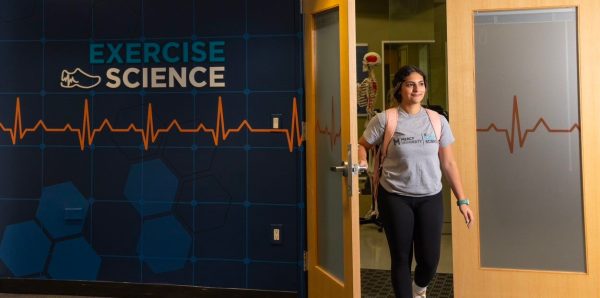Mercy Educates About DisAbility Awareness
October was the month of Breast Cancer, everyone’s favorite holiday, Halloween, the beginning of Fall, and also celebration of Disability Awareness. Mercy College celebrated DisAbility Awareness by allowing the students on campus to be aware of how a disability can affect one.
Delayney Roubert, a Mercy College student, suffers from the disabilities, Attention Deficit Hyperactivity Disorder or ADHD and Dyslexia. According to the Dyslexia Center of Utah, “70-80 percent of people with poor reading skills, are likely dyslexic. One in five students, or 15-20 percent of the population, has a language based learning disability. Dyslexia is the most common of the language based learning disabilities.”
Which is what Delayney is still facing to this day. “When I was younger, it felt as if the people around me were getting smarter and I was getting dumber,” she said.
Centers for Disease Control and Prevention states that in “recent surveys show that approximately 11 percent of children 4-17 years of age (6.4 million) have been diagnosed with ADHD as of 2011.” Delayney found out that she had both ADHD and Dyslexia when she was as young as four years-old.
“It changed me. It allowed others to bully me. They started to call me names like dumb and retarded. It eventually got to me.”
Delayney eventually entered therapy when she was in the second grade yet it did not help. “The therapist had to bribe me with candy and Barbie dolls. She still did not get any words out of me,” she said.
She was put into therapy because she was not receiving the help she was supposed to get at school.
Self Advocacy is a way that one can stand up for themselves. Molly McCabe, the Associate Director for the Office of ACCESSibility says, “knowing one’s rights in college can be different than the rights that one had in high school. One is more independent than he or she was during their time in high school.”
Standing up for oneself is key when having a disability. “Having self advocacy is not only for ones that have a disability. It is also for those that don’t,” says Molly.
If standing up for oneself does not work, there are steps that one can use to proceed to get the proper help. “For example, if the student is deaf and needs close captions on a video their watching, and the professor does not put them on and continues not to do so, the next step is to tell someone in a higher position, like a dean, a pact mentor, even the director of accessibility,” Molly says.
***
Having many learning styles is one of the ways that one with a disability is able to function. According to the Visual Learning Alliance, “65 percent of the world’s population are visual learners.”
The typical visual learner is usually one that makes, “Use of graphic organizers is effective in improving students’ reading comprehension. Students using graphic organizers show achievement benefits across content areas and grade levels. Achievement benefits are also seen with students with learning disabilities. The process of developing and using a graphic organizer enhances skills such as developing and organizing ideas, seeing relationships, and categorizing concepts. Use of graphic organizers aids students in retention and recall of information. The use of graphic organizers supports implementation of cognitive learning theories: dual coding theory, schema theory, and cognitive load theory,” according to a study that was done by The Institute for the Advancement of Research in Education.
Gaming can also take a part in how a student can improve their learning capability. According to Edutopia’s article, ‘Games Support Multiple Learning Styles,’ “The learner playing Portal, for example, must use visual-spatial learning to effectively navigate the game.”
By doing so, gaming an alternative to paying attention in class. The visuals from playing a video game allows the player to try getting towards his or her goal: passing that level they are on or even finishing the game. That focus will then transfer to focusing in class.
Kinesthetic learning another way that a person with disabilities is able to learn. According to Edutopia’s article, “Some games get us physically moving, either through whole bodies or “hands-on” experience.”
Games like the Kinect, an add-on to the Xbox, is an example of kinesthetic learning. This game requires the player to be physically active with the game that one is playing.
Auditory learning is for ones that learn by hearing. According to Studying Style, “about 30 percent of the population, auditory learners absorb information best through the sense of hearing.” These learners usually do well by listening to a oral presentation, audiobooks, and everyones favorite, listening to music.
According to the Edutopia’s article, “digital games have sounds, music and other auditory elements that give hints and clues for players to incorporate while playing. Consider having students collaborate to learn and play other educational games, as well as analyze other auditory components of games.”
If one has a disability just remember there are people on campus that want to listen. There are also alternatives that can help one with their disabilities. There is no shame of hiding it.

Britney is a Journalism major at Mercy College. She was raised in New York City and her hobbies include attending concerts, attending protests, and re-watching...








